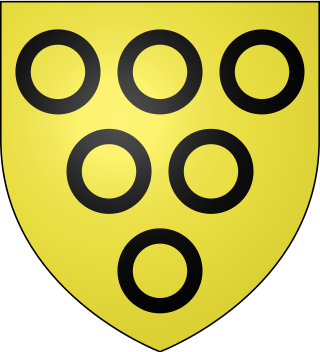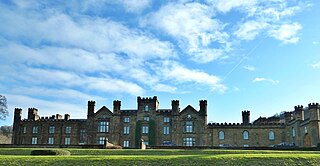
The Countess Pillar is a 17th-century monument near Brougham, Cumbria, England, between Penrith and Appleby. It is two miles east of Penrith on the A66. The square top of the pillar is brightly painted and carries sundials on its sides. It was erected by Lady Anne Clifford in 1656 to mark the place where she said goodbye for the last time to her mother, Margaret Clifford, Countess of Cumberland.

Earl of Lonsdale is a title that has been created twice in British history, firstly in the Peerage of Great Britain in 1784, and then in the Peerage of the United Kingdom in 1807, both times for members of the Lowther family.

James Lowther, 1st Earl of Lonsdale was an English country landowner and politician who sat in the House of Commons for 27 years from 1757 to 1784, when he was raised to the Peerage of Great Britain as Earl of Lonsdale.

Askham is a village and civil parish in the Eden district of Cumbria, England. It is in the historic county of Westmorland. According to the 2001 census the parish had a population of 360, decreasing slightly to 356 at the 2011 Census. It is situated on the eastern edge of the Lake District National Park, 4 miles (6.4 km) south of Penrith. Nearby are the remains of Lowther Castle, the site of the annual Lowther Show, a three-day event of country pursuits.

Wordsworth House is a Georgian townhouse situated in Cockermouth, Cumbria, England, and in the ownership of the National Trust. It was built in the mid-18th century. William Wordsworth was born in the house in 1770. The house is a Grade I listed building. It is open to the public as a writer's house museum from March to October each year.

Lowther Castle is a crenellated country house in the historic county of Westmorland, which now under the current unitary authority of Westmorland and Furness, in the ceremonial county of Cumbria, England. The estate has belonged to the Lowther family, latterly the Earls of Lonsdale, since the Middle Ages. It is a fully managed ruin, open to visits by the public to the shell of the castle and some of the gardens since 2011. Additional work was completed since that time, most recently on the extensive gardens.

Armathwaite Castle is in the village of Armathwaite, Cumbria, England, by the River Eden. Originally built to defend against Scottish raiders in the 15th century, it was converted into a mansion and today is a Grade II* listed building.

William Lowther, 1st Earl of Lonsdale, KG, also known as Sir William Lowther, 2nd Baronet, of Little Preston, from 1788 to 1802, and William Lowther, 2nd Viscount Lowther, from 1802 to 1807, was a British Tory politician and nobleman known for building Lowther Castle.
Westmorland in North West England was abolished in 1974 following Ted Heath's Local Government Act 1972. Westmorland became a part of Cumbria along with Cumberland, parts of Yorkshire and Lancashire, including the Furness peninsular. In 2022 Westmorland was reconstituted as Westmorland and Furness following the abolition of Cumbria County Council. Westmorland and Furness have no High Sheriff as Cumbria has remained the ceremonial county.
Lancelot Edward Lowther, 6th Earl of Lonsdale, OBE, DL was an English peer, the fourth and youngest son of Henry Lowther, 3rd Earl of Lonsdale.
Anthony Edward Lowther, Viscount Lowther was an English courtier and soldier.
James Hugh William Lowther, 7th Earl of Lonsdale, was a British peer.

Hugh Clayton Lowther, 8th Earl of Lonsdale was the eldest son of James Lowther, 7th Earl of Lonsdale, and the only son by his first wife Tuppina Cecily Bennet.

William John Frederick Vane, 3rd Duke of Cleveland, styled The Hon. William Vane from 1792 to 1813, The Hon. William Powlett from 1813 to 1827 and Lord William Powlett from 1827 to 1864, was a British politician.

Wilton Castle is an early 19th-century mansion, built on the site of a medieval castle, now converted into residential apartments, situated at Wilton, in Redcar and Cleveland, North Yorkshire, England. It is a Grade II listed building.

Hipping Hall is a country house hotel on the border of Lancashire, Cumbria and North Yorkshire, near Kirkby Lonsdale.

Wharton Hall in Wharton, Cumbria, England, is a medieval fortified manor house.

Burrow Hall is a large 18th-century country house in Burrow-with-Burrow, Lancashire, England, which lies in the Lune Valley on the A683 some 2 miles (3 km) south of Kirkby Lonsdale.

Edward Bowring Stephens, was a British sculptor from Devon. He was honorary secretary of the Institute of Sculptors circa 1861.
Camilla Ann Lowther is a British fashion booking agent and the founder of Camilla Lowther Management.
















